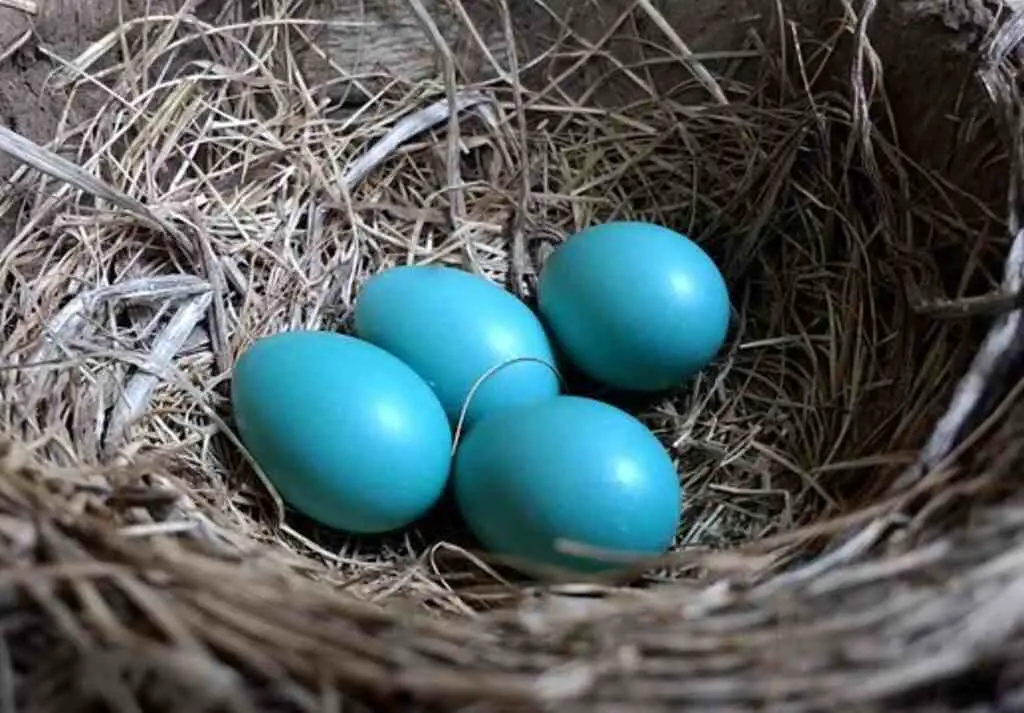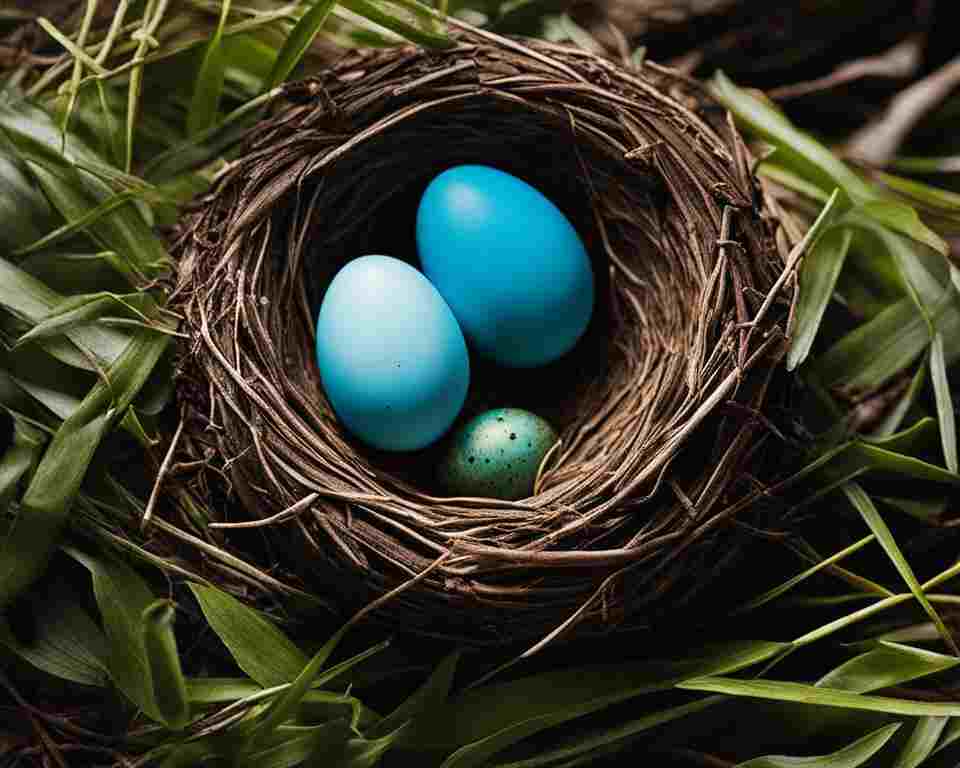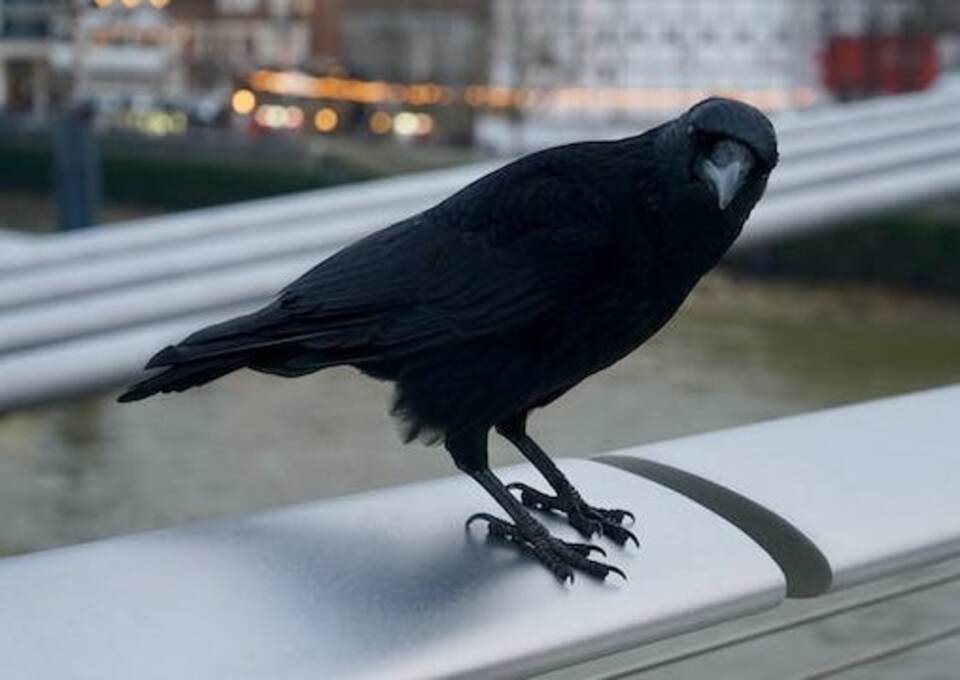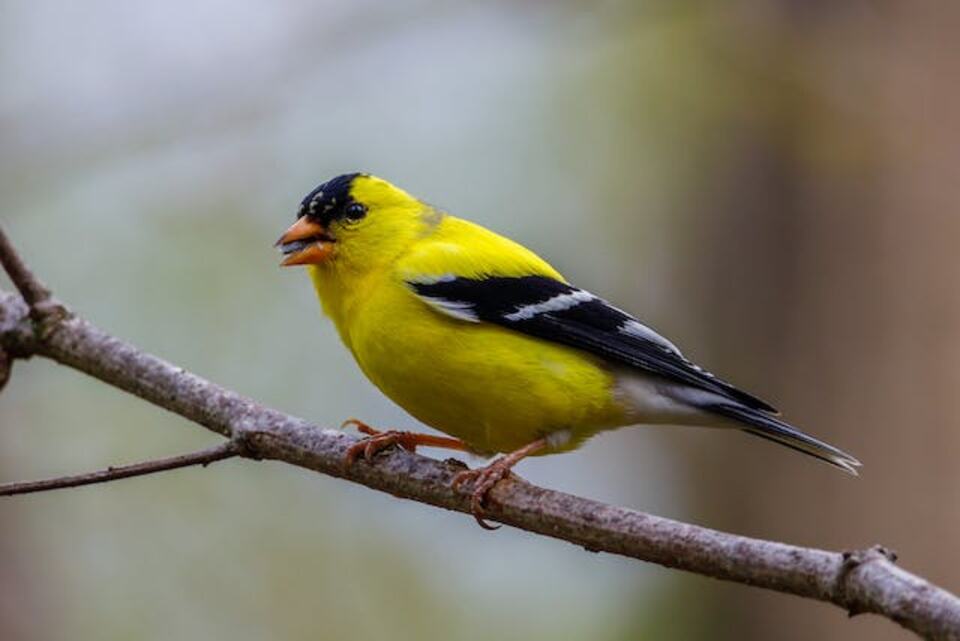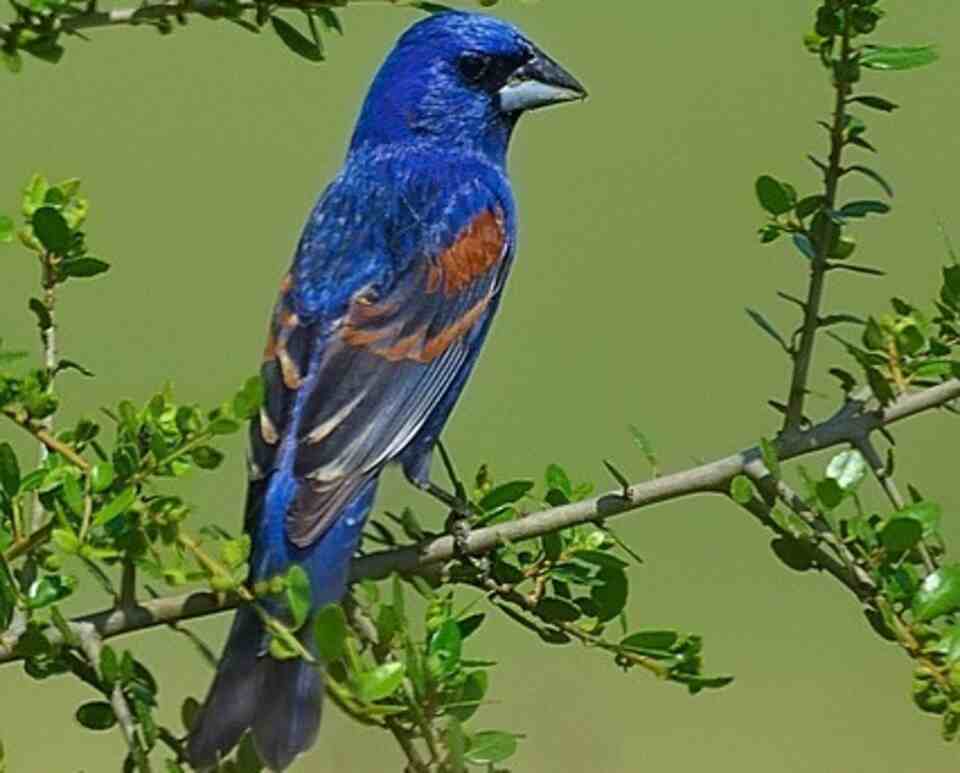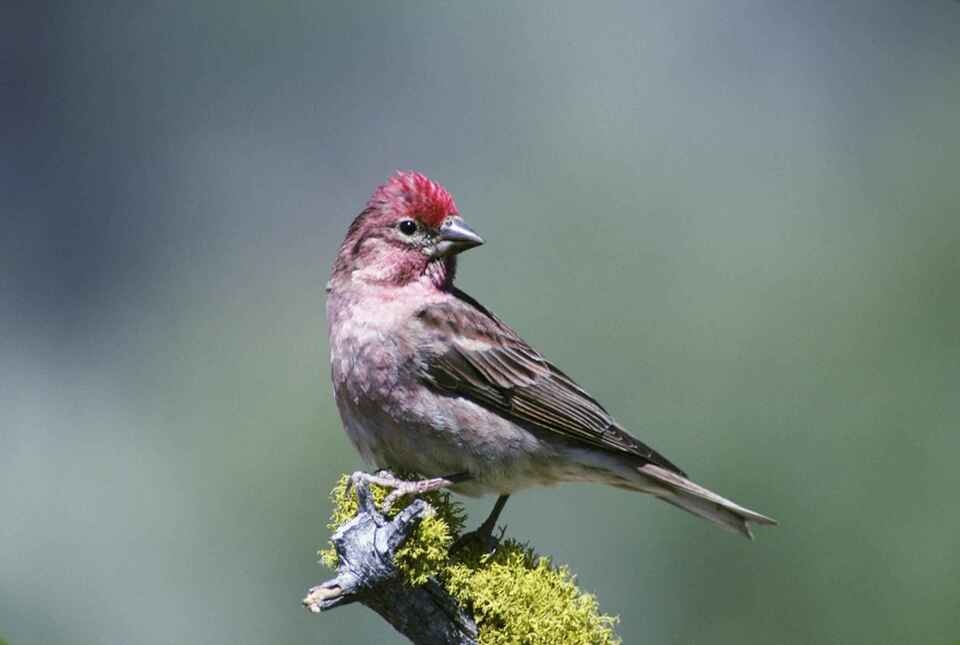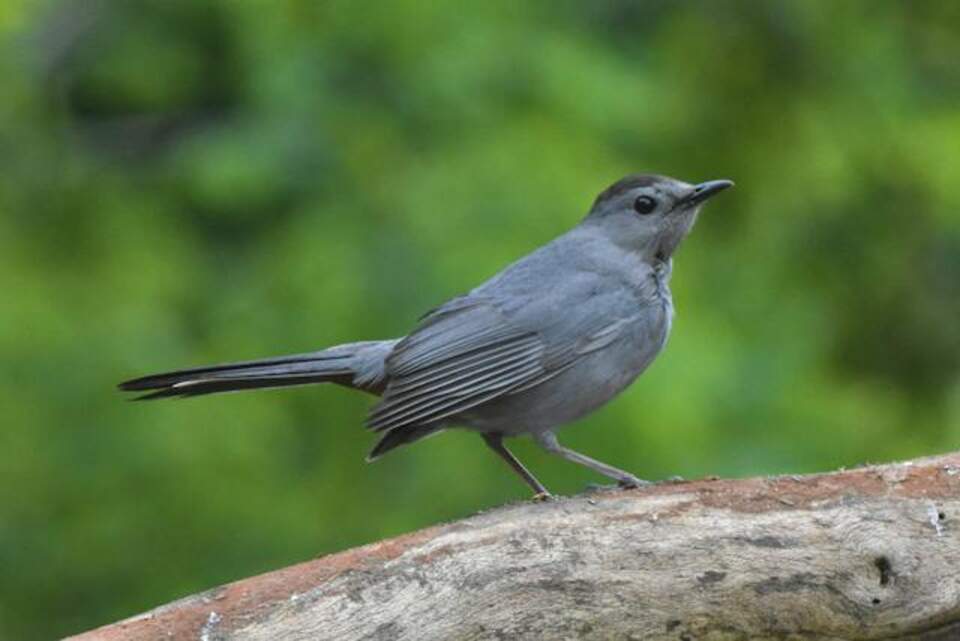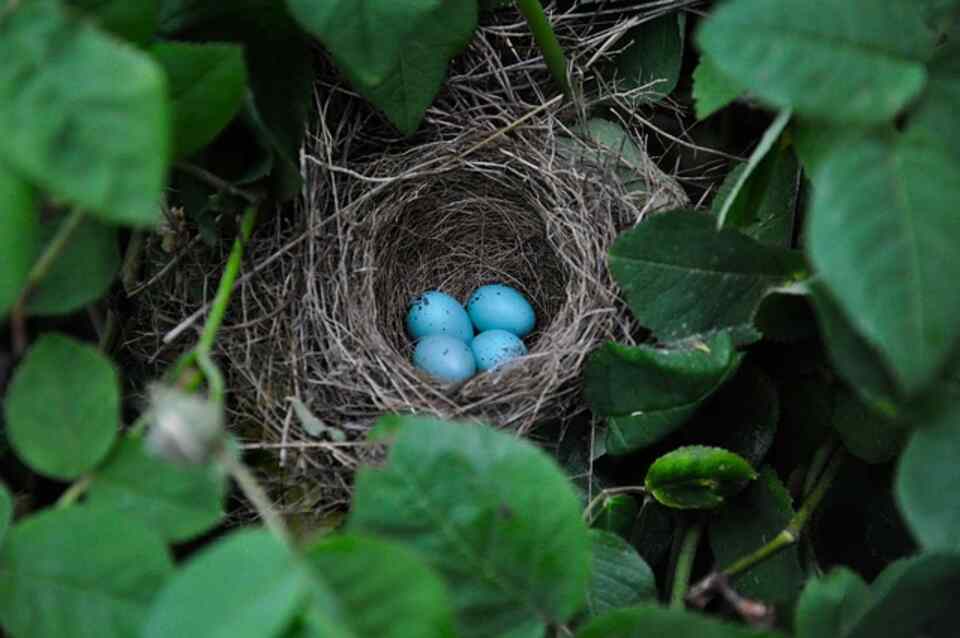Ever wondered which bird lays blue eggs? In this fascinating look into the world of ornithology, we’ll explore the species known for their distinctive blue eggs. From robins to rare songbirds, discover the beauty and variety of these avian wonders and learn a bit about the science behind their colorful creations.
Table of Contents
- 1 Key Takeaways:
- 2 American Crow
- 3 American Goldfinch
- 4 American Robin
- 5 Blue Grosbeak
- 6 Blue Jay
- 7 Cassin’s Finch
- 8 Eastern Bluebird
- 9 European Starling
- 10 Gray Catbird
- 11 Other Birds that Lay Blue Eggs
- 12 How do blue eggs get their color?
- 13 Online Egg Databases and Resources
- 14 Conclusion
- 15 FAQs
- 16 What color are Cardinal eggs?
- 17 What color are Crow eggs?
- 18 What bird lays red eggs?
- 19 Are blue eggs healthier?
- 20 What color are Robin’s eggs?
- 21 What do Catbird eggs look like?
- 22 What color are Hummingbird eggs?
- 23 What does a Chickadee’s eggs look like?
- 24 What color are Sparrow eggs?
- 25 What color are Wren eggs?
- 26 Source Links
- 27 Author
Key Takeaways:
- There are over 20 different bird species in North America that lay blue eggs.
- Some common blue egg-laying birds include the American Crow, American Goldfinch, American Robin, Blue Grosbeak, Blue Jay, Cassin’s Finch, Eastern Bluebird, European Starling, Gray Catbird, House Finch, Lesser Goldfinch, Mountain Bluebird, Northern Mockingbird, Red-Winged Blackbird, Varied Thrush, and Western Bluebird.
- Blue eggs can range in shade or hue, from pale blue to bright blue to turquoise-blue.
- Online resources and databases, such as GardenBird and the Wisconsin bird egg identifier, can assist in the identification process.
- Exploring the world of avian reproduction and learning about the birds that lay blue eggs adds to the beauty and diversity of the natural world.
American Crow
The American Crow is a large all-black bird, about 16-20 inches long, with a wide neck and a long straight bill. Both male and female crows have the same appearance. They are opportunistic scavengers, feeding on a variety of things including insects, spiders, frogs, snakes, and other birds’ eggs and young. They do not typically visit feeders. American Crows can be found in various habitats such as fields, open wooded and forested areas, river edges, shores, towns, cities, and parks.
When it comes to nesting, they build nests in large shrubs or trees as high as 20 feet. Each brood typically consists of 3-9 eggs, which range in color from brighter blue-green to a dull green or blue-gray with heavy gray and brown blotching. The eggs measure approximately 1.4 – 1.9 inches by 1 inch, and both parents incubate them for about 18 days.
| Bird Species | Egg Color | Egg Size (Inches) | Nest Appearance | Habitat | Adult Bird Appearance |
|---|---|---|---|---|---|
| American Crow | Blue-gray with gray and brown blotching | 1.4-1.9 by 1 | Built in large shrubs or trees as high as 20 feet | Fields, wooded areas, river edges, shores, towns, cities, parks | All-black, about 16-20 inches long with a wide neck and a long straight bill |
American Crows are distinctive birds known for their all-black appearance and intelligence. They can be found in a variety of habitats, ranging from open fields to urban areas. They build their nests high up in trees or shrubs and lay eggs with a blue-gray color and unique blotching patterns. The eggs are relatively large in size and are incubated by both parents for about 18 days.
Knowing the characteristics of bird species that lay blue eggs, such as the American Crow, can help birdwatchers and nature enthusiasts identify birds more accurately. By observing the adult bird’s appearance, nest appearance, and habitat, combined with knowledge of the eggs’ size and color, birdwatchers can gain a deeper understanding of these fascinating avian creatures.
American Goldfinch
The American Goldfinch is a small bird, measuring approximately 4.5 inches in length. It has a bright yellow body, black wings with white stripes, and a short orange beak. The breeding females have a similar appearance to the males, but their bodies are lemon yellow. These beautiful birds primarily feed on seeds from flowers, weeds, grasses, and small trees, with some insects as well. If you want to attract American Goldfinches to your backyard, try offering thistle seed (Nyjer) in a feeder.
The American Goldfinch is commonly found throughout the contiguous United States and the southern part of Canada, in areas such as weedy fields, roadsides, orchards, and backyards. When it comes to nesting, American Goldfinches build their nests in deciduous shrubs or trees, sometimes even conifers. They place their nests on branch forks as high as 20 feet. The nests are constructed with plant fibers and fine grasses. They have a cup-like shape that provides a secure environment for the eggs.
The clutches of American Goldfinches consist of 2-7 eggs, which are very pale blue in color. Occasionally, the eggs may have faint brown spots on the larger end. These delicate eggs measure approximately 0.5 inches by 0.5 inches. The female American Goldfinch incubates the eggs for about 12-14 days, while the male brings food to her. Once the eggs hatch, both parents take turns feeding the chicks until they are ready to leave the nest.
| Egg Color | Egg Size | Incubation Period |
|---|---|---|
| Very pale blue | Approximately 0.5 inches by 0.5 inches | 12-14 days |
“The beautiful American Goldfinch is known for its bright yellow plumage and its distinct song.”
Adult Bird Appearance
- Bright yellow body
- Black wings with white stripes
- Short orange beak
American Robin
The American Robin is a medium-sized bird, approximately 10 inches long, with a gray/brown upper body, brown/orange underparts, and a yellow beak. The female has a lighter head and underparts compared to the male. American Robins primarily feed on earthworms, insects, and fruit. They can be found throughout the US and Canada, in fields, parks, wooded and forested areas, mountains, and even backyards.
When it comes to nesting, American Robins build their nests in various locations such as the lower half of a tree, rain gutters, outdoor lights, and more. Each clutch consists of 3-5 bright sky blue or blue-green eggs without spots. The eggs measure approximately 1.1 inches long by 0.8 inches wide, and they are incubated for 12-14 days.
| Egg Color | Egg Size | Nest Appearance | Habitat | Adult Bird Appearance |
|---|---|---|---|---|
| Bright Sky Blue or Blue-Green | Approximately 1.1 inches long by 0.8 inches wide | Built in various locations such as the lower half of a tree, rain gutters, outdoor lights, and more | Fields, parks, wooded and forested areas, mountains, backyards | Gray/brown upper body, brown/orange underparts, yellow beak |
“The American Robin is a common sight in many North American landscapes. Its bright sky blue eggs are a striking feature of its reproductive cycle. The female builds a nest in various locations, where she lays a clutch of 3-5 eggs. These eggs are a vibrant blue color, resembling the color of the sky on a sunny day. The nest and eggs are a testament to the beauty and diversity of nature, captivating the eyes and hearts of bird enthusiasts.”
The Nesting Behavior of American Robins
American Robins exhibit interesting nesting behaviors, choosing a variety of locations for their nests. This adaptability allows them to thrive in different environments, from urban areas to natural habitats. The nests are constructed with a combination of mud, twigs, grass, and other materials, providing a sturdy structure for the eggs and young.
The eggs themselves are a wonder to behold, with their bright sky blue or blue-green coloration. This color serves as a visual signal to potential predators, indicating that the eggs are a valuable resource and should not be disturbed. The female robin diligently incubates the eggs for about 12-14 days, ensuring their proper development and survival.
“The nesting behavior of American Robins showcases their adaptability and resourcefulness. Their ability to successfully raise their young in a variety of environments is a testament to their resilience and adaptability. The brilliant blue color of their eggs adds an element of wonder and beauty to the natural world, captivating both birdwatchers and casual observers alike.”
The American Robin is just one of many bird species that lay blue eggs. Each species has its own unique characteristics, including egg size, nest appearance, habitat, and adult bird appearance. By observing and learning about these birds, we can gain a deeper appreciation for the wonders of avian reproduction and the diverse beauty found in nature.
“The brilliant blue eggs of the American Robin are a sight to behold. Their vivid color and the tireless efforts of the parents to protect and incubate them showcase the incredible natural processes that take place in the world around us. The American Robin’s nesting behavior and the appearance of their eggs add a touch of magic to our everyday lives, reminding us of the beauty and intricacies of the natural world.”
Blue Grosbeak
The Blue Grosbeak is a striking bird known for its beautiful pale blue eggs. This species measures approximately 8 inches long and has a large, bright blue body, large silver bill, and chestnut wingbars. The female has a primary color of light cinnamon with darker colored wings. Blue Grosbeaks primarily feed on insects, seeds, and grains, and they can be attracted to grain and birdseed at feeders. These birds are commonly found in thick shrubbery and areas with tall trees.
When it comes to nesting, Blue Grosbeaks build small cup-shaped nests of twigs and miscellaneous organic materials. They typically place their nests in low-lying trees, shrubs, and bushes. Each brood of Blue Grosbeaks consists of 3-5 pale blue eggs, occasionally with brown spots. The eggs measure approximately 0.8 inches by 0.7 inches and are incubated for 12-13 days by the female.
The adult Blue Grosbeak is a stunning bird with its bright blue plumage, making it a favorite among birdwatchers. Its distinctive appearance and unique nesting habits set it apart from other bird species that lay blue eggs. Observing the Blue Grosbeak and its pale blue eggs in their natural habitat is a rewarding experience for bird enthusiasts.
Blue Jay
The Blue Jay is a fascinating bird known for its striking appearance and its ability to mimic other bird calls. When it comes to egg-laying, Blue Jays produce eggs that range in color from pale blue to light brown. These eggs can be a valuable clue for bird enthusiasts and researchers in identifying the species.
Adult Bird Appearance
The Blue Jay is a large bird, about 12 inches long, with a medium blue and white body, blue crest, gray belly, and white face. Both male and female Blue Jays have the same appearance, making it challenging to distinguish between the sexes based on looks alone. Their vibrant blue plumage and distinctive crest make them a beautiful addition to any bird-watching session.
Habitat and Nest Appearance
Blue Jays are commonly found in forested areas with mixed tree types, as well as in suburbs and urban areas. When it comes to nesting, they build large nests made from twigs, bark, and mud. These nests are typically found on tree branches about 5-50 feet above the ground.
Egg Size and Appearance
The Blue Jay lays eggs that can range in color from pale blue to light brown. These eggs often have gray or brown spots, giving them a unique appearance. The eggs measure approximately 1 inch by just under 1 inch, and both parents take turns incubating them for a period of 17-18 days.
| Species | Egg Color | Egg Size | Incubation Period |
|---|---|---|---|
| Blue Jay | Pale blue to light brown | Approximately 1 inch by just under 1 inch | 17-18 days |
Cassin’s Finch
The Cassin’s Finch is a small bird, measuring approximately 6 1/4 inches long. It has a brown coloration with a red cap, brown stripe across its cheeks, and a white underside with light pink streaks on the chest. The female has a similar appearance but lacks the red or pink coloration, with heavily streaked brown chest and belly. Cassin’s Finches primarily feed on seeds, buds, and berries, with occasional insects. They can be attracted to black-oil sunflower seeds at feeders. These birds are commonly found in open forested areas rich with conifers.
When it comes to nesting, Cassin’s Finches build their nests high up in conifers, typically about 30+ feet above the ground. The nests are small cup-shaped structures made from twigs and miscellaneous organic materials. Each clutch typically consists of 3-6 eggs that are light bluish with black, brown, and purplish speckles. The eggs measure approximately 0.7-0.8 inches by 0.5-0.6 inches. The female bird incubates the eggs for about 12-14 days before they hatch.
| Egg Color | Egg Size | Nest Appearance | Habitat | Adult Bird Appearance |
|---|---|---|---|---|
| Light bluish with black, brown, and purplish speckles | Approximately 0.7-0.8 inches by 0.5-0.6 inches | Small cup-shaped nests made from twigs and organic materials | Open forested areas with conifers | Brown coloration with a red cap, brown stripe across cheeks, and white underside with light pink streaks on chest |
Eastern Bluebird
The Eastern Bluebird is a small bird, measuring approximately 7 inches long. It is known for its royal blue coloration, orange throat and breast, and white belly and undertail. The female Eastern Bluebird has a similar appearance to the male but with more muted colors. These birds primarily feed on insects and spiders during the spring and summer months, while they switch to small fruit during the fall and winter. They can be attracted to feeders with suet, sunflower seeds, dried fruit, and jelly.
The Eastern Bluebird is commonly found in wide-open spaces, such as fields and meadows. They also prefer habitats with scattered trees or perches, which they use for hunting insects. When it comes to nesting, Eastern Bluebirds are cavity nesters. They often utilize old woodpecker holes in trees or manmade nest boxes. The female bird builds the nest and typically keeps it for multiple broods throughout the breeding season.
Each clutch of Eastern Bluebird eggs consists of 4-5 pale blue eggs, sometimes appearing white, without any blemishes or discoloration. The eggs are small, measuring approximately 0.9 inches by 0.8 inches. The female Eastern Bluebird incubates the eggs for 11-19 days until they hatch. Once the eggs hatch, both parents take turns feeding the nestlings until they fledge and leave the nest.
| Egg Size | Nest Appearance | Habitat | Adult Bird Appearance |
|---|---|---|---|
| Pale blue | Small cavity nests | Wide-open spaces, fields, meadows | Royal blue coloration, orange throat and breast, white belly and undertail |
European Starling
The European Starling is a stunning bird that is known for its glossy bluish or pale green eggs. With its iridescent shades of purple and black, adorned with white speckles, the European Starling is a sight to behold. This medium-sized bird, measuring approximately 7 1/2 inches long, has a long, pointed gray bill in fall and a yellow bill in spring, along with a short tail. Both male and female European Starlings share the same appearance, making them a distinctive species to identify.
European Starlings primarily feed on insects, seeds, and fruit, and they are known to consume a wide variety of food at feeders. These birds are commonly found in urban and residential areas throughout the United States and Canada, including backyard lawns, parks, fields, and more. When it comes to nesting, European Starlings are cavity nesters, utilizing existing cavities or crevices in trees or manmade structures. They often build nests in large colonies, creating a bustling and active community.
Each brood of European Starlings consists of 4-6 eggs, which can range in color from glossy bluish to pale green. The eggs are elliptical in shape and measure approximately 1.1-1.3 inches in length and 0.8-0.9 inches in width. The female starling incubates the eggs for a period of 12-14 days before they hatch. Once hatched, the parents diligently care for their young, providing them with food and protection as they grow.
| Species | Egg Color | Egg Size | Nest Appearance | Habitat | Adult Bird Appearance |
|---|---|---|---|---|---|
| European Starling | Glossy bluish or pale green | Approximately 1.1-1.3 inches by 0.8-0.9 inches | Cavity nests in trees or manmade structures | Urban and residential areas | Iridescent shades of purple and black with white speckles |
The European Starling’s eggs, with their unique coloring and the bird’s vibrant appearance, add to the diversity and beauty of the avian world. These striking birds can be observed and appreciated by birdwatchers and nature enthusiasts throughout their range, providing a glimpse into the fascinating world of bird reproduction.
Gray Catbird
In this section, we will explore the Gray Catbird, a bird species known for laying pale blue eggs. The Gray Catbird is a medium-sized bird, approximately 9 inches long, with a gray coloration, black crown, dark eyes, and a long, thin black bill. These birds primarily feed on insects, seeds, and fruit and can be commonly found in various habitats, including fields, shrubs, and backyards.
When it comes to nesting, Gray Catbirds build their nests in dense shrubs, usually low to the ground. Each clutch consists of 3-4 pale blue eggs, measuring approximately 0.8 inches by 0.6 inches. The adult Gray Catbird incubates the eggs for about 12-13 days.
| Egg Color | Egg Size | Nest Appearance | Habitat | Adult Bird Appearance |
|---|---|---|---|---|
| Pale blue | 0.8 inches by 0.6 inches | Nests in dense shrubs | Fields, shrubs, and backyards | Gray coloration, black crown, dark eyes, long, thin black bill |
The Gray Catbird is a fascinating bird with its distinct appearance and pale blue eggs. Its ability to adapt to different habitats makes it a common sight in fields, shrubs, and even backyards. Finding their nests and observing their nesting behaviors can provide valuable insights into the world of avian reproduction.
By understanding the characteristics of birds that lay blue eggs, such as the Gray Catbird, birdwatchers and nature enthusiasts can enhance their knowledge and appreciation of avian diversity. The blue eggs laid by these species add a touch of beauty to nature’s palette.
Other Birds that Lay Blue Eggs
In addition to the previously mentioned bird species, there are several others that also lay blue eggs. These include the House Finch, Lesser Goldfinch, Mountain Bluebird, Northern Mockingbird, Red-Winged Blackbird, Varied Thrush, and Western Bluebird. Each of these species has its own unique characteristics and habits when it comes to egg-laying.
The House Finch and Lesser Goldfinch, for example, lay pale blue eggs similar in color to those of the American Goldfinch. The Mountain Bluebird and Western Bluebird, on the other hand, lay bright blue eggs. The Northern Mockingbird lays pale blue eggs with no spots, while the Varied Thrush lays bluish eggs with occasional brown spots. The Red-Winged Blackbird lays bluish or greenish blue eggs. Each of these species has its own distinct nesting habits, egg sizes, and incubation periods.
To further illustrate the differences between these bird species, let’s take a closer look at their egg characteristics in the table below:
| Bird Species | Egg Color | Egg Size | Nest Appearance | Habitat | Adult Bird Appearance |
|---|---|---|---|---|---|
| House Finch | Pale blue | 0.7-0.8 inches by 0.5-0.6 inches | Various locations such as trees, shrubs, and bushes | Open forested areas rich with conifers | Small bird with a brown coloration |
| Lesser Goldfinch | Pale blue | 0.7-0.8 inches by 0.5-0.6 inches | Deciduous shrubs or trees, sometimes even conifers | Weedy fields, roadsides, orchards, backyards | Small bird with a bright yellow body and black wings with white stripes |
| Mountain Bluebird | Bright blue | 0.9 inches long by 0.8 inches wide | Low-lying trees, shrubs, bushes | Thick shrubbery and areas with tall trees | Bird with a large, bright blue body and large silver bill |
| Northern Mockingbird | Pale blue | 0.8 inches by 0.6 inches | Dense shrubs, typically low to the ground | Various habitats, including fields, shrubs, backyards | Medium-sized bird with gray coloration and a black crown |
| Red-Winged Blackbird | Bluish or greenish blue | 1.1-1.3 inches by 0.8-0.9 inches | N/A | Urban and residential areas | Medium-sized bird with iridescent shades of purple and black and white speckles |
| Varied Thrush | Bluish with occasional brown spots | 0.8 inches by 0.7 inches | Low-lying trees, shrubs, bushes | Thick shrubbery and areas with tall trees | Medium-sized bird with a primary color of light cinnamon |
| Western Bluebird | Bright blue | 1 inch by just under 1 inch | Large nests made from twigs, bark, and mud | Forested areas with mixed tree types, suburbs, urban areas | Large bird with a medium blue and white body and blue crest |
As you can see, each of these bird species brings its own unique beauty to the world of avian reproduction. Their blue eggs add a touch of color and wonder to the natural world, and by understanding their characteristics and habits, we can appreciate them even more.
Whether it’s the pale blue eggs of the House Finch, the bright blue eggs of the Mountain Bluebird, or the bluish or greenish blue eggs of the Red-Winged Blackbird, each species has its own fascinating story to tell.
How do blue eggs get their color?
Blue eggs derive their color from pigments, primarily biliverdin and protoporphyrin, byproducts of hemoglobin breakdown. In certain bird species, such as robins, the pigment oocyanin is applied during egg formation, permeating the entire shell.
This process results in a distinct blue color both inside and outside the egg. The intensity of the blue is influenced by factors like pigment concentration and shell thickness. Understanding this intricate biological mechanism sheds light on the captivating variety of colors found in avian eggs.
Online Egg Databases and Resources
When it comes to identifying bird eggs, there are several online resources and databases available that can be invaluable tools for birdwatchers and nature enthusiasts. These resources provide information, photos, and features to help identify different bird species and their respective eggs.
One such resource is the GardenBird bird egg identifier, which allows you to compare any discarded or used shells you may find in your garden or elsewhere. With the help of GardenBird, you can quickly and accurately identify bird eggs based on their appearance, size, and other characteristics.
This database provides comprehensive information on various bird species, including color photographs of eggs, descriptions of nests and clutch sizes, egg measurements, and breeding distribution maps.
With the Wisconsin bird egg identifier, you can easily access detailed information and visually compare eggs to aid in identification.
The British Trust for Ornithology (BTO) also offers resources and information on birds and their nesting behaviors. The BTO website provides valuable insights into bird breeding and nesting patterns, egg characteristics, and other related information.
By utilizing the resources and databases provided by organizations such as GardenBird, the Wisconsin bird egg identifier, and the BTO, bird enthusiasts can enhance their knowledge and identification skills, contributing to a deeper understanding and appreciation of the avian world.
Table: Comparison of Online Egg Databases and Resources
| Resource | Features | Availability |
|---|---|---|
| GardenBird | – Bird egg identifier – Comparison of egg shells – Photos and information – Fast and accurate identification | Online |
| Wisconsin bird egg identifier | – searchable database – Color photographs of eggs – Descriptions of nests and clutch sizes – Egg measurements – Breeding distribution maps | Online |
| BTO | – Resources and information on bird breeding and nesting – Insights into egg characteristics and behaviors | Online |
By leveraging these online resources, bird enthusiasts can unlock the world of bird egg identification and gain a deeper understanding of avian reproduction. Whether you are a beginner or an experienced birdwatcher, these databases and tools offer valuable information and insights that can enhance your birding experience and contribute to the conservation of these beautiful creatures.
Conclusion
In conclusion, we have explored the fascinating world of birds that lay blue eggs. From the American Crow to the Western Bluebird, each species has its own unique characteristics and habits when it comes to egg-laying. The range of blue hues seen in these eggs, from pale blue to bright turquoise, adds to the beauty and diversity of the natural world.
By understanding the characteristics of these birds and their eggs, birdwatchers and nature enthusiasts can more easily identify them in the wild. The various online resources and databases available provide valuable information and aids in the identification process. Whether you encounter blue eggs in your garden or while exploring nature, these resources can help you unravel the mystery of which bird species they belong to.
The avian reproduction process is truly remarkable, and the blue eggs laid by these species are a testament to the wonders of nature. So the next time you come across a blue egg, take a moment to appreciate the extraordinary journey it represents, from the bird’s nest to the skies above.
FAQs
What color are Cardinal eggs?
Cardinal eggs have a pale greenish-blue color. The female cardinals carefully choose well-hidden locations for their nests, where the delicate blue eggs are protected.
What color are Crow eggs?
Crow eggs are usually pale blue or greenish with scattered markings. The precise color can vary, but these eggs are generally smaller compared to the bird’s size.
What bird lays red eggs?
No bird species naturally lays entirely red eggs. Egg colors are generally variations of blue, brown, or white.
Are blue eggs healthier?
Eggshell color doesn’t affect nutritional value. Blue eggs, like those of Araucana or Ameraucana chickens, are simply a result of genetics and do not indicate differences in health benefits.
What color are Robin’s eggs?
Robin’s eggs have a distinctive bright blue color. The vibrant hue serves as a visual signal to adult robins, making it easier for them to locate and identify their own eggs.
What do Catbird eggs look like?
Catbird eggs are typically pale blue or greenish-blue with small, subtle markings. Their appearance blends well with the nest environment, providing a level of protection.
What color are Hummingbird eggs?
Hummingbird eggs are minuscule and white. The lack of pigmentation allows the mother hummingbird to assess the development stages of the embryos through the translucent shell.
What does a Chickadee’s eggs look like?
Chickadee eggs are generally white or creamy in color, sometimes with fine speckles. These small, delicate eggs are carefully incubated by the attentive chickadee parents.
What color are Sparrow eggs?
Sparrow eggs vary in color, often featuring shades of white, gray, or pale blue. The specific color can depend on the sparrow species, but they typically have a plain appearance.
What color are Wren eggs?
Wren eggs come in various colors, including pale blue, pink, or white. The specific coloration may differ between wren species, but these small eggs are charming additions to the avian world.

